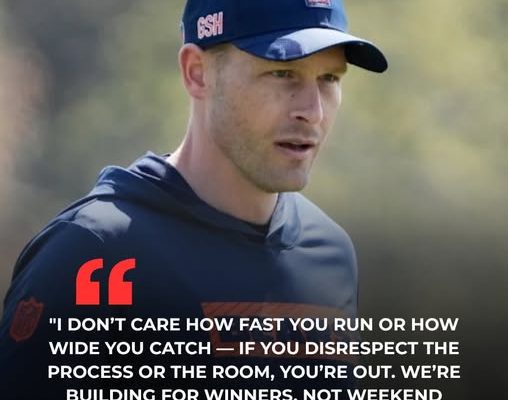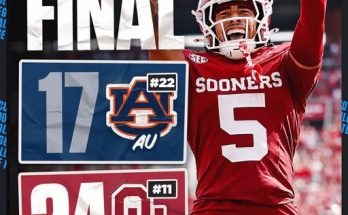The Chicago Bears have always prided themselves on being more than just a football team. In a league where talent is king and production on the field often trumps everything else, Chicago has long sought to maintain an identity rooted in discipline, accountability, and a strong locker room culture. That’s why the news of the team releasing two rookies for unprofessional conduct and failing to fit into that culture has sent shockwaves through both the fanbase and the wider NFL community. It’s not often that a team decides to cut ties with players this early in their careers, especially those who were expected to develop into future contributors, but the Bears’ decision underscores just how seriously they take the non-negotiable standards within the organization.
According to multiple sources close to the situation, the two rookies—whose names have not yet been officially confirmed by the team but have been identified in various reports—were let go following several incidents that raised red flags about their commitment to the team’s values. While details remain somewhat guarded, insiders have hinted at repeated lateness to team meetings, poor practice habits, and questionable behavior off the field. In a profession where structure and punctuality are critical, such lapses can quickly erode trust between players and coaches, especially when it happens before the regular season even begins. The Bears’ leadership, led by general manager Ryan Poles and head coach Matt Eberflus, reportedly felt that continuing to keep these players around would send the wrong message to the rest of the locker room.
This is not the first time the Bears have shown a willingness to take a hard line when it comes to team culture. Since Poles took over as GM in 2022, there’s been a visible shift toward building a roster full of players who not only meet athletic benchmarks but also embrace a team-first mentality. The Eberflus-led coaching staff has been equally committed to reinforcing discipline and accountability, even coining the “HITS principle” as a foundational philosophy—hustle, intensity, takeaways, and playing smart. Any player unwilling or unable to consistently meet those standards risks finding themselves on the outside looking in. This latest move is just the most recent—and perhaps most public—example of that ethos in action.
For fans, the immediate reaction has been a mix of surprise and grudging respect. On one hand, cutting rookies before they’ve had a chance to develop feels like a drastic step, especially when draft capital or scouting resources have already been invested in them. On the other, many recognize that allowing problematic behavior to linger, even in small doses, can snowball into bigger issues later on. Veterans in the locker room often set the tone, but rookies can impact team chemistry too. If the newcomers are seen slacking off or resisting coaching, it can frustrate the rest of the roster and diminish the collective buy-in that championship teams require. Chicago’s decision, while tough, likely reflects an understanding that protecting the integrity of the locker room outweighs any potential on-field upside these rookies might have brought.
It’s worth noting that the NFL is a notoriously demanding environment where even supremely talented athletes can struggle to adapt to the professional expectations. College football allows for certain leniencies—class schedules, lighter media exposure, and more hands-on guidance from coaches and staff. But once a player enters the league, they are expected to handle a grueling schedule of meetings, practices, workouts, travel, film study, and media obligations. The margin for error is slim, and the competition is relentless. For rookies, the adjustment period is often a sink-or-swim situation. Those who immediately buy into the culture and work ethic demanded by the team have a chance to thrive, but those who resist or underestimate the importance of professionalism quickly find themselves on thin ice.
In the Bears’ case, this move might also be a signal to the rest of the roster—especially the other rookies—that the leash is short when it comes to off-field issues. Chicago’s rebuild under Poles has been methodical, and the front office has placed a premium on bringing in players with strong character backgrounds. This includes vetting prospects during the pre-draft process, interviewing coaches and teammates from college programs, and monitoring social media habits. For two players to slip through that filter and then quickly flame out suggests either that certain warning signs were overlooked or that these rookies simply failed to live up to the expectations once they arrived in Chicago. Either way, the organization acted swiftly to correct what they saw as a problem.
From a purely football standpoint, the loss of two rookies may not cripple the Bears’ depth chart, but it does create an opportunity for other players to step up. Chicago is still shaping its roster heading into the season, and training camp is the ultimate proving ground for fringe players. The sudden release of these rookies means more reps for others at their respective positions, more snaps in preseason games, and potentially a faster track for undrafted free agents or practice squad hopefuls to make an impression. For every player cut in August, another player gets the chance to secure a job, and that reality will not be lost on those fighting for roster spots.
Critics of the move may argue that the Bears should have invested more time in developing these players, especially considering the resources spent on scouting and signing them. There’s also the possibility that some of these issues could have been resolved with more mentoring from veterans or stricter internal discipline before resorting to outright release. However, the counterpoint is that professional football is not a charity and not a place where coaches can afford to babysit. Every minute spent managing distractions takes away from preparing the team to compete on Sundays. In that light, Chicago’s decision might be seen not as impulsive but as a necessary step to protect the larger mission.
The Bears’ locker room leaders are likely to support this kind of decisive action. Veteran players—especially those who have been through both winning and losing seasons—understand that distractions can derail a team’s momentum. They also know that culture is something you either protect every day or risk losing altogether. In fact, NFL history is filled with examples of teams with immense talent that underachieved because they failed to maintain accountability. Conversely, some of the league’s most successful franchises have thrived in part because they enforced a no-nonsense standard from top to bottom. Chicago seems to be aiming for the latter category, and if that means making uncomfortable cuts, so be it.
In the bigger picture, this episode could serve as a wake-up call for incoming rookies across the league. The NFL is an environment where the difference between success and failure often comes down to intangibles like preparation, focus, and adaptability. Physical talent gets a player in the door, but professionalism keeps them there. The Bears’ decision reinforces the idea that no one is immune to the consequences of not meeting expectations, regardless of where they were drafted or how much potential they might have.
For the two players involved, the road forward will be challenging but not necessarily over. The NFL is a league of second chances, and other teams may be willing to take a flyer on them if they believe the issues can be corrected. However, their reputations have undoubtedly taken a hit, and they will have to work twice as hard to prove that they’ve learned from this experience. In many cases, players who get cut for off-field reasons either rebound by overhauling their approach or fade quietly out of the league. Which path they take will depend largely on their willingness to change.
From a PR perspective, the Bears have managed to control the narrative fairly well by avoiding sensational details and framing the decision as a matter of protecting team culture. This approach prevents unnecessary embarrassment for the players while still sending a clear message to the public and to the locker room. It also aligns with how other disciplined organizations handle similar situations—keep it professional, keep it in-house as much as possible, and let the decision speak for itself.
While it remains to be seen how much this move will impact the Bears’ on-field performance this season, it unquestionably sets a tone. Chicago is clearly unwilling to compromise on the values it believes will lead to sustainable success. Fans who have endured years of inconsistent play and failed rebuilds may take comfort in seeing an approach that prioritizes long-term culture over short-term convenience. Whether or not that translates into wins in 2025, it lays a foundation for the kind of team the Bears want to become—one that demands the best from everyone in the building, every single day.
This decision also comes at a time when the Bears are trying to turn a corner competitively. With a revamped roster, a young quarterback to develop, and a division that feels more open than it has in years, the window of opportunity is there if the team can capitalize. But opportunity without discipline is wasted, and Chicago’s leadership seems intent on ensuring that no one player—rookie or veteran—derails the progress they are trying to make. By acting swiftly and decisively, the Bears have reinforced the idea that the standard is the standard, and that those who can’t meet it won’t be sticking around to drag the team backward.
In the end, this is a move that tells us as much about where the Bears are headed as it does about the two players who are now gone. It’s about building a locker room that can handle adversity, focus on the task at hand, and push toward a common goal without internal friction. It’s about creating an environment where every player knows that their actions—on and off the field—have consequences. And perhaps most importantly, it’s about sending the message that Chicago’s commitment to its culture is not just talk; it’s a real, tangible force that shapes every decision the organization makes.



